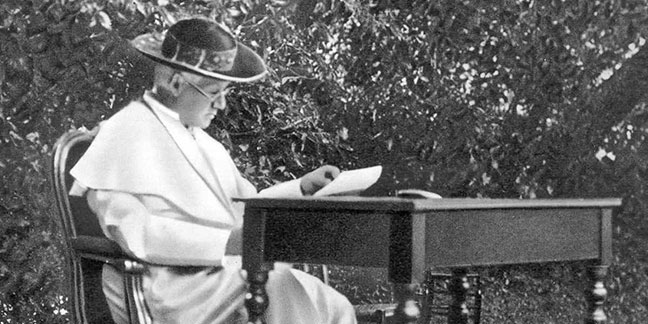 Pope Pius X, born Giuseppe Melchiorre Sarto, was the first pope elected in the 20th century. The 257th pope was elected in 1903 and died 11 years later in 1914, just as World War I was erupting.
Pope Pius X, born Giuseppe Melchiorre Sarto, was the first pope elected in the 20th century. The 257th pope was elected in 1903 and died 11 years later in 1914, just as World War I was erupting.
He was born on June 2, 1835, at Riese, near Venice, one of 10 children in a poor family. He felt a calling to be a priest at a young age and was ordained in 1858. After 26 years, he was named bishop of Mantua, Italy, and in 1893, he became patriarch of Venice.
His papal motto was “Instaurare Omnia in Christo,” or “to restore all things in Christ.” As pope, he advocated frequent and even daily reception of the Eucharist (which scandalized his critics) and in 1910 he decreed that the age of first Holy Communion should be lowered from 12 to 7, “the age of reason or discretion.” He hoped that, by lowering the age of first Holy Communion, children and their parents would be able to fortify their relationship with Christ, and he flatly rejected the heresy that the Eucharist was a reward for virtue instead of a remedy for human frailty.
He encouraged the reading of the Bible among laypeople, reformed the liturgy, promoted clear and simple homilies, and brought back Gregorian chant. He revised the Breviary, reorganized the curia, and initiated the first-ever codification of Church law (which would be completed in 1917, after his death).
He strongly defended the Church against the heresies of indifferentism and relativism. He also waged an unwavering war against modernism – warning in a 1907 encyclical “Pascendi Dominici Gregis” (better known as “On the Doctrine of the Modernists”) of the dangers that this atheistic philosophical movement posed by rejecting tradition and promoting revolution in all aspects of civic life.
He was known for rejecting many of the trappings of the papal office and simplifying papal ceremonies. He abolished the custom of the pope dining alone, which had been established by Pope Urban VIII, and invited his friends to eat with him.
He also developed a reputation as being very friendly with children. He carried candy in his pockets to give street children in Mantua and Venice, and taught catechism to them. During papal audiences, he would gather children around him and talk to them about things that interested them. His weekly catechism lessons in the courtyard of San Damaso in the Vatican always included a special place for children, and his decree requiring the Confraternity of Christian Doctrine (CCD) catechism program in every parish was partly motivated by a desire to reclaim children from religious ignorance.
In 1908, Pius X lifted the United States out of its missionary status, in recognition of the growth of the American church. Fifteen dioceses were created in the U.S. during his pontificate, and he named two American cardinals. He was very popular among American Catholics, partly due to his poor background, which made him appear to them as an ordinary person who was on the papal throne.
After an earthquake in Messina in 1908, he filled the Apostolic Palace with refugees after the Italian government delayed coming to their aid.
During his pontificate, many famed Marian images were granted a canonical coronation, including the Our Lady of Aparecida, Our Lady of Chiquinquira of Colombia and Our Lady of Carmel of New York.
He died on Aug. 20, 1914, of natural causes reportedly aggravated by worries over the beginning of World War I. His last will and testament bears the striking sentence: “I was born poor, I have lived in poverty, and I wish to die poor.”
He was canonized by Pope Pius XII on May 29, 1954. Because of his devotion to the Eucharist and his promotion of frequent Holy
Communion, he is celebrated as the “Pope of the Blessed Sacrament.”
— CNA/EWTN, www.catholiconline.org and Wikipedia


